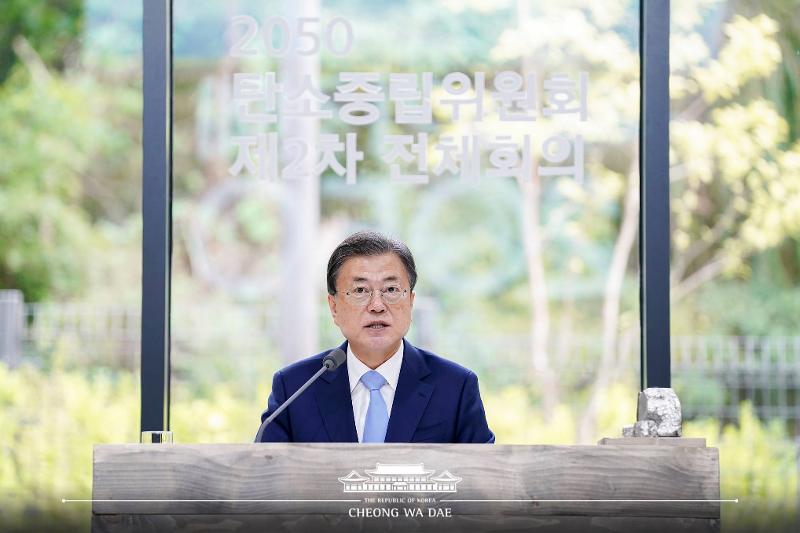
President Moon Jae-in on Oct. 18 speaks at the second meeting of a presidential committee on carbon neutrality by 2050 on Nodeul Island in Seoul's Yongsan-gu District. (Cheong Wa Dae's official Facebook page)
By Kim Eun-young and Kim Hayeon
The government has announced its goal to reduce CO2 emissions by 2030 to 40% of 2018 levels and achieve net-zero emissions by 2050.
To maximize such cuts, coal-fired power generation will be suspended until 2050.
President Moon Jae-in on Oct. 18 attended the second meeting of the presidential committee on carbon neutrality by 2050 on Nodeul Island in Seoul's Yongsan-gu District. The event deliberated and decided on scenarios for carbon neutrality by 2050 and a revised plan for nationally determined contributions (NDCs) for 2030.
For the 2030 target for lowering emissions, the reduction goal was raised from the original target of 26.3% from 2018 levels to 40%.
To achieve carbon neutrality by 2050, the committee decided on two scenarios. The first aims to maximize emission cuts by abolishing coal-fired power generation, while the second seeks to abolish coal-fired power plants but retain liquefied natural gas to boost the use of new technologies including carbon capture, utilization and storage.
Though both scenarios were selected to flexibly respond to potential changes by 2050, they share the goal of abolishing coal to produce power while removing emissions. The draft announced in August was revised after collecting feedback from people from all walks of life including those from industry and civic groups.
President Moon said at the meeting, "If for no other reason than to enhance our economy's continued growth and national competitiveness, we will move to reduce greenhouse gas emissions and achieve carbon neutrality faster than before. The nation's fate depends on it."
"These two scenarios prove our willingness to reduce emissions as much as possible in each sector as well as our determination to increase the amount of carbon absorption through the development of relevant technologies and the expansion of carbon sinks. We will do this while even keeping future technological advances in mind."
"This is also the way to fulfill my Administration's pledge to increase its bridging role between leading countries and latecomers in terms of climate crisis responses," he said. "It will also be an opportunity for both our domestic low-carbon technology and our industries to expand their advances overseas."
Fiscal support for carbon neutrality in next year's budget has jumped to KRW 12 trillion and will keep rising, he added.
The government will finalize the scenarios and NDCs in next week's Cabinet meeting ahead of their official release next month at the United Nations Framework Convention on Climate Change in the U.K.
eykim86@korea.kr